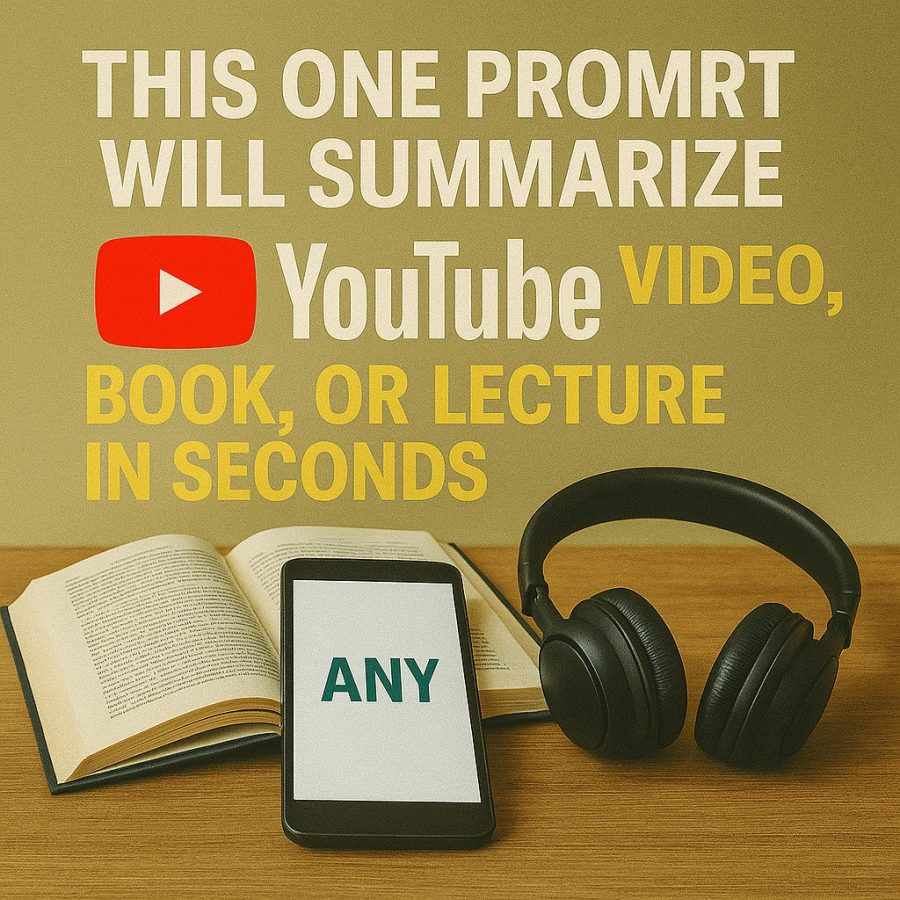Views: 5
Information overload is real. Between long YouTube videos, dense non-fiction books, and extended lectures, our brains get tired before we learn what matters. Imagine if you could get the essence of any content in seconds. That possibility is real by using this one prompt that will summarize ANY YouTube video, book, or lecture quickly. Today I will show you how you can use that prompt, why it works, and how to adapt it.
The key phrase I want you to remember is “this one prompt will summarize ANY YouTube Video, Book, or Lecture in Seconds”. You will see it often. It ties together the promise, the method, and the outcome.
Why You Need a Universal Summary Prompt
Save Time, Learn More
Watching a two-hour video or reading a long book takes commitment. Most people skip or skim. Tools and AI summarization let you absorb the key ideas. Studies show summarization improves retention and supports clearer thinking. (myessaywriter.ai) When you get a fast summary, you skip noise. You focus on insights.
Improve Recall and Decision-Making
Summaries help you remember what you learned and decide what deserves deeper focus. Leaders, students, professionals often must decide quickly what to act on. AI summaries reduce cognitive load. They allow quicker decisions. (Acorn Labs)
Customize to Your Learning or Work Style
Not all summaries are equal. Depending on your goal you might want bullet points, analogies, key quotes, or action items. The right prompt gives you control. It lets you extract what aligns with your learning style or your work.
What Makes a Prompt Powerful
For a summary prompt to deliver on its promise—that it will summarize ANY YouTube video, book, or lecture in seconds—it needs to satisfy certain properties.
- Clear instructions
You must tell the AI what format you want. Do you want a summary, bullet points, takeaways, or action steps? You must specify length or style. - Supply or get access to the source content
For videos or lectures you often need the transcript. For books, at least a chapter or a summary of chapters. If you can paste the source (or a representative excerpt), the AI can work with that. - Focus on audience needs
What is your purpose? Is it teaching someone else? Is it studying for an exam or creating content? That defines which points matter most. - Allow edits or filters
You may ask for excluding spoilers, focusing on arguments, or highlighting methods or statistics. That customization makes summary more useful.
The One Prompt You Can Use Anywhere
Here is a universal prompt you can paste into ChatGPT (or similar LLM) that will work for any YouTube video, book, or lecture. It will summarize the content in seconds if you provide the transcript or text you want summarized.
Prompt:
*You are my Universal Summary Assistant. I will provide you with the transcript or text from a YouTube video, book chapter, or lecture. Summarize the content in three parts:
- Key Takeaways: the most important points in bullet form (no more than 7 bullets).
- Supporting Details: brief explanations or examples that illustrate each takeaway (one or two sentences each).
- Application: suggestions for how to use or apply what was learned, with at least two action items.
Limit the summary to 200-words if summarizing a video or lecture transcript of up to one hour. If longer, scale proportionally. Confirm you understood before proceeding.*
Once you paste the transcript or readable text, the tool (ChatGPT) will confirm it has enough content. Then it returns the summary in the three parts above.
How to Use That Prompt for Different Media
For YouTube Videos or Lectures
- First extract the transcript. Many videos have autogenerated transcripts. If not, use a tool (for example Tactiq) or manual transcription. (Tactiq)
- Paste the transcript or part that covers main sections.
- Use the universal prompt above.
- Optionally ask for timestamps or notable quotes. If you want to focus on arguments rather than narrative, specify that.
For Books or Non-Fiction Texts
- Use physical or digital copy. You can paste chapter summaries or excerpts instead of whole book when necessary due to length.
- You might break long work into segments (for example 3 chapters) and run the prompt on each part separately.
- After you have segment summaries, run another prompt that synthesizes them into one whole summary.
Example Walk-Through
Suppose you have a 45-minute lecture on psychology. You extract transcript. You feed that transcript into ChatGPT with the universal prompt. It returns:
- Key Takeaways: perhaps 5 core psychological principles.
- Supporting Details: one or two sentences each explaining research or example.
- Application: how to use those principles personally (study techniques, habit building, etc.)
Then perhaps you do the same for two additional lectures. You compare summaries. You notice overlapping insights. You refine.
For a book, imagine three chapters from a business book. You run three summaries. Then ask for combined summary: what ideas repeat, what the structure of argument is, what actions you can take.
Why It Works Based on Research
- AI summarization tools work well when given clear instructions. Precision in the prompt increases output quality. (Acorn Labs)
- The act of summarizing itself boosts understanding and retention. Learning science affirms that summarizing helps clarify structure and reinforce memory. (myessaywriter.ai)
- Using bullet points or segmented summary helps with scanning. Users can quickly decide what to dig deeper into.
Tips to Make Summaries Even Better
To get maximum value from the prompt:
- Set limit: specify word count or bullet count. That avoids rambling.
- Define your angle: maybe you care about methodology, persuasion, humor, or critique. Ask for that.
- Include questions: you can ask the summary to include what remains unclear or what questions the author left unanswered.
- Ask for analogies or metaphors: helps cement understanding.
- Verify with source: summaries can miss nuance. Keep enough of original content handy.

When Not to Use It
There are times when summarizing alone doesn’t replace full content:
- Fiction or narrative where style, tone, voice matter deeply. Summary omits voice.
- Art or visual content where imagery or visuals are central.
- Deep technical work where full detail, proofs, or data matter.
In those cases you may need to read the original, but the summary prompt still helps you decide whether to invest that time.
Variants: Customize the Prompt
Here are variants of this one prompt will summarize ANY YouTube Video, Book, or Lecture in Seconds you can adapt:
- Bullet variant: ask for only bullet points and no supporting details if you only need a quick scan.
- Quote-rich version: ask to include 2-3 direct quotes that capture tone or strong ideas.
- Critic mode: ask for strengths, weaknesses, assumptions.
For example:
“You are my Critical Summary Assistant. Provide key takeaways, supporting details, and at least two direct quotes. Also list strengths, weaknesses, and possible biases.”
Tools That Help Automate Transcript → Summary
- Some tools extract YouTube transcripts automatically. Then you paste into ChatGPT. (Tactiq)
- NoteGPT is an example that lets you summarize YouTube video content with minimal manual effort. (NoteGPT)
- AI summarization articles and platforms (for books, documents, reports) offer features like transcript generation, summary in bullet or paragraph formats, customizing length. (Acorn Labs)
How to Incorporate Summary Prompt into Routine
- At the end of each week, pick one lecture or long video you watched. Run the prompt. Save the summary.
- Before reading a new book, skim with summary of parts to preview structure.
- Use summaries to prepare for meetings or discussions. Consolidate other people’s content in seconds.
Sample Summary: Demonstration
Here is how the process works in a mock example. Assume lecture on “Learning How We Learn” including topics like memory, spaced repetition, attention.
Key Takeaways
- Memory works by reinforcing neural connections.
- Spaced repetition beats massed practice.
- Focused attention is limited resource.
- Retrieval practice improves long term retention.
- Metacognition helps monitor learning.
Supporting Details
- The lecture describes experiments where students who spaced review sessions remember more than peers who crammed.
- Attention gets depleted; distractions reduce encoding so protecting focus windows matter.
- Retrieval practice (testing oneself) strengthens memory more than re-reading.
Application
- Setup a study schedule using spaced repetition tools like flashcards.
- Before reading, state questions to guide attention.
This kind of summary helps you teach others, study efficiently, or build content.
How to Measure Success of Summaries
You know the prompt works when:
- You feel you grasped the essence without reading or watching the whole source.
- You can explain the content to someone else clearly.
- Key points align with what you consider valuable.
- You take action based on the application section.
Sample Universal Prompt (Polished Version)
Here is a polished universal prompt you can keep in your notes. Use it whenever you want to summarize ANY YouTube video, book, or lecture fast.
Universal Summary Prompt:
You are my Quick Digest Assistant. I will paste transcript or text from a YouTube video, book chapter, or lecture. Please produce a summary in three parts: Key Takeaways (no more than 7 bullets), Supporting Details (one or two sentences each), Application (at least two actions I can take). Limit summary to approx 200 words for up to 1 hour of content. Confirm you have enough content or need more before summarizing.
You can tweak “200 words” up or down depending on content length.
Common Questions About Summary Prompt Use
Can AI misrepresent facts in summary?
Yes. AI could omit nuance or misinterpret. Always check supporting details or direct quotes if accuracy matters.
Does providing transcripts violate copyright?
If transcript is publicly available or you have permission, fine. If not, ensure you respect rights. Use only content you are permitted to use.
Will summary lose voice or style?
Yes. Summaries by design reduce style and omit tone. If voice matters (say in literature or creative work), you might want variant prompt that includes “include style features.”
Bringing It All Together
You now have a powerful tool. Use this one prompt will summarize ANY YouTube video, book, or lecture in seconds to pull out what matters fast. Protect your time. Learn smarter. Customize the process. Add it to your toolkit.
With practice you will refine the prompts, select your angle, and trust summaries to guide when to dive deeper. That is how you turn information overload into knowledge you can use.


](https://altpenguin.com/wp-content/uploads/2025/08/veed-ad.webp)

